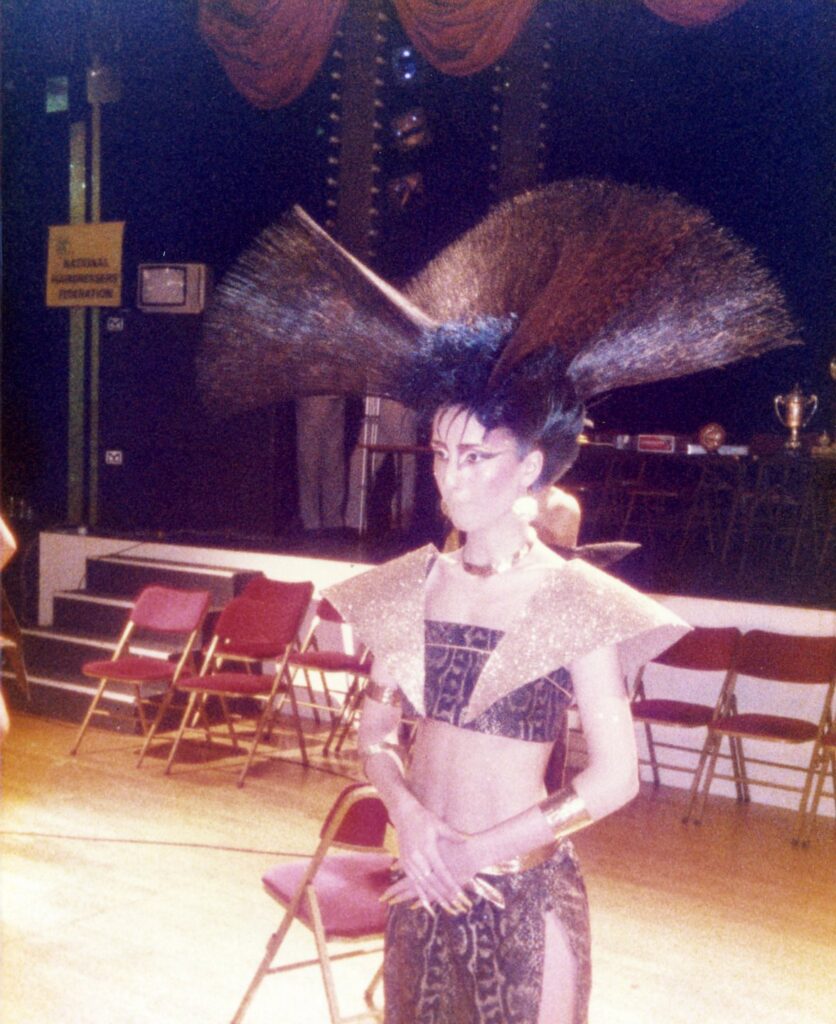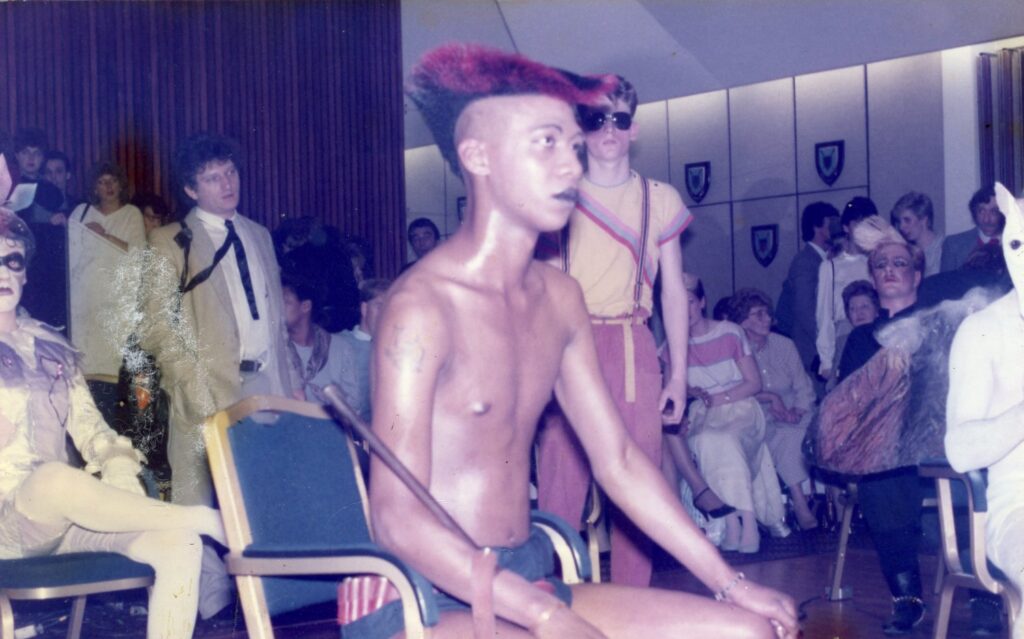Back in the 1980s, the sound of my mother’s hairdressing salon, Reflections, was one of real and fake sympathy, neighbourhood scandal, and the low hum of overhead dryers. It was in this place I learnt the art of eavesdropping, listening in on conversations as I swept up remnants of tumbleweed hair, serving hot refreshments to ladies awaiting attention, smoking Silk Cuts as their rollers were combed out. You’d hear all about the private lives and outrageous behaviour of the Mrs-next-doors, their tragic deaths, or gleeful gloating of those who thought they were something but had now lost everything.
Customers often visited the salon for ‘cul-de-sac’ cuts in the fashion of Princess Diana, but the older women were reminiscent of those who featured in Three Salons at the Seaside, wanting a shampoo and set once a week, with a stern backcomb and Elnett fix of their heavily-tinted hair. Their style icon at the time was Mrs Thatcher or the Queen, and they would dress in a similar way, with court shoes, American Tan tights and a knitted suit, complete with pearls and clip-on earrings for a special occasion.
In the back room of the salon was a colouring station, where peroxide, tint and various chemicals were squeezed from tubes into a plastic bowl, then frantically mixed with a brush, as if they were cake icing, or a meringue mix. The air would fill with fumes, fag ash, and the rising volume of gossip, as the conservative class who formed much of the clientele – local gentry, racehorse trainers, mill dynasties – discussed whatever they had read in that day’s papers. A small speaker was situated above the till, which would sometimes play Steve Wright in the Afternoon on Radio1, Simon Bates’ Our Tune (‘Love Theme from Romeo & Juliet’ by Henry Salomon and his Orchestra) or the sunbathing music of Chris Rea’s On The Beach.
This was the era of Jilly Cooper’s Rivals, Alexis Carrington, and brash 80s perfumes. The waiting area, where a banquette upholstered in Laura Ashley fabric overlooked a glass coffee table piled with glossy magazines, was where the transformation began. Each client would be treated to a Nescafé instant coffee (no, we didn’t have fresh back then), and as they awaited their appointment, the ambient soundtrack of snipping scissors, the rubbery schlup of highlighter caps, and the crumpling of bleach-smeared foil into a tray would form an aural backdrop. There was little escape from the sensory dominance emanating from scented strips glued inside pages of Vogue, Elle and Cosmopolitan, where brash fragrances such as Opium, Poison, and Giorgio Beverly Hills floated into the firmament. These perfumes marked the decade as much as the music, fashion and culture of the era, and even now, revisiting them in 2025, they act as a portal, or madeleine into times past.
It is now February, and I am sitting in a cutting cape, where I am a client, rather than a salon girl. This week, my third book, Base Notes: The Scents of a Life, will be published, and I’m heading out on tour at bookshops and venues around the country. In order to look less like a freelance bag-lady, my sister (who has continued the family trade) is restyling my hair. The sound of the salon is not dissimilar to our mother’s, the hum of wafting blow-dryers is quieter due to the progress in technology, but there are new ingredients to the aural ambience, too: straightening irons that emit steam (ones that no longer make hair crackle in the heat), the sharp, wet squeak of razors shredding sections of hair in the nape of your neck, and a barely noticeable air filtration system, one that carries fumes and fogs from fixing products into the air outside. Between blow drying blasts, the sound of shellac nails tapping on iPhone screens is noticeable, the occasional whirr of a coffee machine, or the hot milk pipe crafting cappuccinos. There is a subtle layer of running water from the rinsing basins. Bottles of peroxide being squeezed into bowls break the lull in silence, as the scrunch of colouring foils, now much thinner and delicate than in times past, create the most obvious auditory link to the salon of our childhood.

All salons must pay a PRS licence if they legally intend to play music. For my sister, this is an essential part of the general ambience. She believes most salons play terrible music, having been tormented by the appalling music taste of various establishments she has worked at over the years. “That’s why I opened my own salon,” she laughs, “I couldn’t take any more Lady Gaga a hundred times a day. It was like sonic noise torture.” Militantly policing the playlists is a detail she takes pride in, her speciality is 80s wine bar music, R&B, soul, house, jazz and laidback poolside listening. Today, she’s playing Rene & Angela, Jocelyn Brown and Patrice Rushen, which is a well-placed selection for sitting in the chair, imagining how much improved we will all look whilst patiently waiting for our tip-outs to take.
Contrasting with the conversations of our mother’s salon, her clients today (who are awaiting colour changes) are discussing the joy of living in Timperley, and the legend of Frank Sidebottom, their exuberant chatter punctuated only by the sound of metal hair clips, and the almost inaudible comb threads of grey blending techniques. Beyoncé, whose mother was also a hairdresser, once said that she’d listen to everyone’s problems as if she were their therapist, and probably did a much better job, a statement I couldn’t agree more with. Beyond the aesthetics, the best stylists are empaths, able to connect on a deep emotional level, even for an hour or two.
Essentially, I’d argue that the salons of now are quieter, even though they might contain more staff and people than in previous eras. Technology is the main reason for this. Alongside the nature of salon visits, gone are the days of shampoo and sets twice a week, or the regular blow-drys and tint re-touching for dinner parties or big nights out. The snap of perming roller elastics is a long-lost memory, consigned to the bin of time. There is still a magical element to the process though. By spending a few hours staring at your own reflection, in a space very much geared up to the female experience, when you finally walk out of the door, you are revitalised, relaxed and most importantly, presentable once again. Almost human, until the next time you return.
Adelle Stripe’s Base Notes: The Scents of a Life is published by White Rabbit. Listen to the Spotify playlist here.



